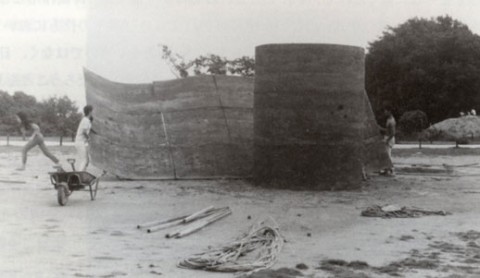News, Reviews, Reports
Nobuo Sekine’s “Phase — Mother Earth” Under Reconstruction
 As of yesterday, Nobuo Sekine has been recreating his Phase — Mother Earth (1968) at Den’en Chofu Seseragi Park in West Tokyo.
As of yesterday, Nobuo Sekine has been recreating his Phase — Mother Earth (1968) at Den’en Chofu Seseragi Park in West Tokyo.
Created in October 1968 in the Suma Rikyu Park in Kobe, and consisting of a 2.2 x 2.7m cylindrical hole in the ground and an adjacent cylinder of earth of the same dimensions, this piece is one of the signature works of the Mono-ha movement of the late 1960s and early ‘70s. This is the first time Sekine is recreating the work, to commemorate 40 years since it marked a turning point in Japanese postwar art history.
However, unlike in 1968 when the work was made by Sekine and other artists of the Mono-ha group such as Koshimizu Susumu, who dug the earth out of the ground themselves, this time the earth will be excavated by a mechanical digger and coordinated by specialist engineers and only part of it will be made by hand. Sekine will, however, be present throughout to oversee the project.
The reasons for not doing it by hand this time are that there are water mains buried in the earth, and that part of the earth on site is suitable for excavation, meaning that specialist techniques are required to ensure the work is successfully recreated. In his autobiography Fukei no Yubiwa (Ring of Nature), Sekine wrote of how unexpectedly difficult it was to dig up the earth in 1968, and understandably now that he is in his sixties, he cannot work on the creation of the piece alone.
A few years ago at Wako University, students spent a month attempting to recreate Phase — Mother Earth, but when they removed the mold it turned out that the earth was not of the right consistency and the cylindrical form disintegrated immediately. At the Suma Rikyu Park, the earth had the consistency of pit sand, which mixed together with some concrete, made the work hold together.
Looking back, Sekine says that the realization of Phase Mother Earth in 1968 had a lot to do with unpredictably favourable circumstances, particularly the quality of the earth. They had received no permission from the park authorities as they dug up the ground and were lucky not to have been stopped before they had finished. Sekine suspects that had he applied to make Phase — Mother Earth beforehand, it may well have been turned down for concerns about quality of the earth, the potential risk to underground pipelines, or for health and safety regulations.
It’s interesting to think that had one of these favourable conditions not been present in 1968, one of the pivotal artworks in the early development of the Mono-ha movement, and one of the most iconic developments in postwar Japanese art history might not have come into being.
Construction work on Phase — Mother Earth will continue until October 31, and will be on display from November 1 to 9, from 9am to 5pm. Den’en Chofu Seseragi Park is directly opposite Tamagawa Station on the Tokyu Toyoko line.
For more information on the Mono-ha movement, you can read this article that I wrote for Tokyo Art Beat that introduces the main artists and their ideas.
About & Community
A place to keep abreast of Art Space Tokyo related news, reviews, events and updates.
Art Space Tokyo is a 272 page guide to the Tokyo art world produced and published by Craig Mod & PRE/POST.
It was originally published in 2008 by Chin Music Press.
Current Tokyo exhibitions
Powered by Tokyo Art Beat
